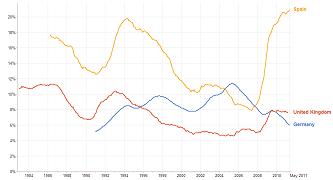Tuesday, July 19, 2011
In 2008, output per worker fell by 0.8 per cent. In 2009, this same measure of productivity declined by a massive 3.1 per cent. This is not normal during recessions, where the shake-out of labour typically causes productivity to rise. Following relatively minor dips in 1980 and 1989, productivity rose during the recessions of the early 1980s (substantially) and 1990s.
One reason for the perverse figures observed in the recent past may be the very severity of the recession: real wages fell in 2009, and this may have enabled firms to retain workers that would otherwise have been shed, despite stagnation in output. With price inflation continuing at above 4 per cent over the year, there is still a lot of downward pressure on real wages.
This suggests that the simple relationship between changes in unemployment and the rate of output growth which underpins Okun's analysis is misspecified - consideration also needs to be taken of movements in wages. In this respect, the true relationship may be closer to what Tom Hyclak and I once dubbed the 'Fisher curve' - in honour of Irving Fisher's work in the 1920s.
Over the long run, technological progress determines change in productivity. The decline in productivity will be temporary and we will see a return to growth in both productivity and real wages. When this happens, we can expect the Okun relationship to be restored.
Johnes, G. and T.J. Hyclak (1995). The determinants of real wage flexibility Labour Economics, 2 (2), 175-185 DOI: 10.1016/0927-5371(95)80052-Y
One reason for the perverse figures observed in the recent past may be the very severity of the recession: real wages fell in 2009, and this may have enabled firms to retain workers that would otherwise have been shed, despite stagnation in output. With price inflation continuing at above 4 per cent over the year, there is still a lot of downward pressure on real wages.
This suggests that the simple relationship between changes in unemployment and the rate of output growth which underpins Okun's analysis is misspecified - consideration also needs to be taken of movements in wages. In this respect, the true relationship may be closer to what Tom Hyclak and I once dubbed the 'Fisher curve' - in honour of Irving Fisher's work in the 1920s.
Over the long run, technological progress determines change in productivity. The decline in productivity will be temporary and we will see a return to growth in both productivity and real wages. When this happens, we can expect the Okun relationship to be restored.
Johnes, G. and T.J. Hyclak (1995). The determinants of real wage flexibility Labour Economics, 2 (2), 175-185 DOI: 10.1016/0927-5371(95)80052-Y
Monday, July 11, 2011
The graph below shows the unemployment rate series for three European countries - the UK, Germany and Spain.

In the aftermath of the Great Recession, it is clear that unemployment has fallen in Germany while it has risen in the other countries - most severely so in Spain.
An interesting explanation for the relative success of Germany comes in a recent paper by Michael Burda and Jennifer Hunt. They argue that working time accounts - which allow employers to avoid paying overtime by averaging individuals' hours worked over a relatively lengthy period - have resulted in less hiring during the upturn and less firing in the downturn. This interesting finding suggests that such accounts are an institution that might be worth introducing elsewhere.
Subscribe to:
Comments (Atom)
